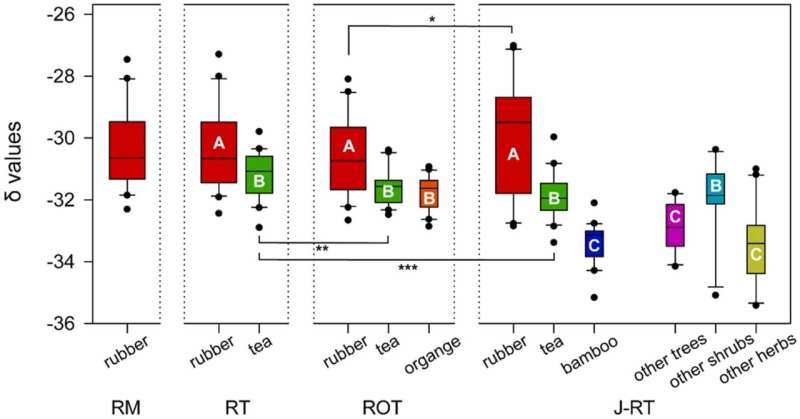This article has been reviewed according to Science X's editorial process and policies. Editors have highlighted the following attributes while ensuring the content's credibility:
fact-checked
trusted source
proofread
Researchers advise limiting the number of intercropping species in rubber-based agroforestry

Rubber-based agroforestry systems are sustainable intercropping systems in which farmers grow multiple crops or livestock alongside rubber trees to improve their income and/or livelihoods, while also reaping the subsequent ecological benefits. However, it is unknown whether adding more intercropped species to the rubber–tea agroforestry system increases the benefits.
In a study published in Agricultural Water Management, researchers from the Xishuangbanna Tropical Botanical Garden (XTBG) of the Chinese Academy of Sciences and the Yunnan Normal University investigated the dynamics of belowground plant competition, competition effects on plant nutrient status, and plant-soil interactions at different rubber-based agroforestry systems in Xishuangbanna.
The researchers selected a rubber monocultural plantation, three agroforestry systems including rubber-tea intercropping, rubber-orange-tea intercropping and a complex jungle-like rubber-tea agroforestry system (a secondary forest), so as to help improve the sustainability and maximize the potential of rubber-tea agroforestry systems.
The researchers mainly applied stable hydrogen and oxygen isotope techniques (2H and 18O) to study plant hydrological niche differentiation and stable carbon isotopes (13C) to study plant water use efficiency.
To analyze how competition affected plants and soil nutrient status, the researchers measured carbon (C), nitrogen (N), phosphorus (P), potassium (K), calcium (Ca), and magnesium (Mg) concentrations of different plant organs (i.e., leaf, stem, and root), litter and soil in these rubber agroforestry systems.
The researchers found that rubber trees absorbed water primarily from deeper soil layers as the number of intercropped species increased and the hydrological niche differentiation between rubber trees and the intercropped plants became more apparent.
In addition, soil nutrient status first improved, but then declined with an increase in the number of intercropped species. However, negative competition effects offset the benefits of intercropping for soil nutrients and water. Rubber trees are the most competitive species in rubber agroforestry systems. P deficiency is a challenge for the growth of diverse intercropped plants.
"We suggest that when establishing or improving rubber-based agroforestry systems, too many species should not be intercropped," said Zhao Fan, first author of the study.
More information: Fan Zhao et al, An increase in intercropped species richness improves plant water use but weakens the nutrient status of both intercropped plants and soil in rubber–tea agroforestry systems, Agricultural Water Management (2023). DOI: 10.1016/j.agwat.2023.108353
Provided by Chinese Academy of Sciences


















